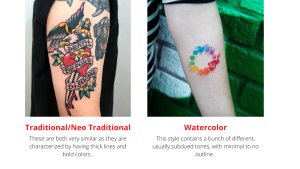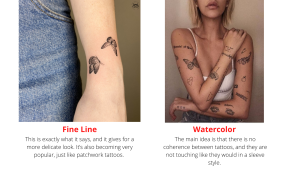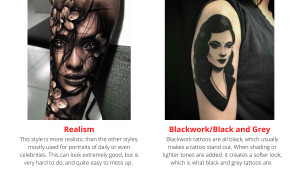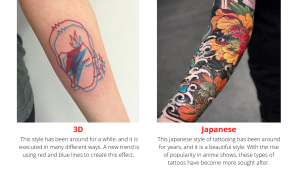Since I was little I have been talking about getting a tattoo, so naturally I got my first one as soon as I could. I was 16 years old, which some tattoo parlors allow if the parent is present. I chose something that was very meaningful to me, so I still like what I got, but I have to admit that 16 is really young. I also made the mistake of getting a spontaneous tattoo as soon as I turned 18, which is the legal age, and now I am stuck with something I do not totally love. It definitely isn’t as bad as some of the tattoo fails I’ve seen, but it also wasn’t my proudest moment. Obviously, I’ve always known tattoos are permanent, but after this it really hit me, and I am still living with the consequences of it. Getting a tattoo is a really big step, so in this article I want to talk about my experience, give some tips, and really stress the importance of taking time to think before getting something done for the first time.
Choosing the Right Tattoo
The first step of getting a tattoo is actually choosing one. Like I said, I chose something really important to me, which is why I still really like it. I do not think a tattoo needs to have a deep story behind it, a lot of people see tattooing as an art form and choose a piece based solely on beauty, but you still need to be sure you are in love with your choice. Below are some different styles of tattooing for you to research, to get a better sense of what you like and what you don’t.
Choosing a Place and Size
After choosing what tattoo you want to get, you have to decide on the placement. Remember that not all tattoos fit well on all parts of the body, plus we move, and lose or gain fat in different areas in our lives. Our tattoos will stretch with us, but they might not look the same afterwards. Other than that, when thinking about placement and sizing, you should also keep in mind how easy it will be to cover up. While tattoos have become more acceptable in today’s society, many places still require employees to cover them up. This includes most healthcare professionals, law enforcement, teachers, bank employees, people who work in the government, and so on. Also, if you want to go into an acting role, having a tattoo can hinder your ability to get roles. For example, the tattoos you have might not fit the character you are auditioning for. A fun fact is that when you do see tattoos on screen they are usually licensed, as showing another artist’s artwork without credit can lead to a copyright suit.
Another thing to think about is pain levels, as certain areas are much more sensitive than others. While everybody is different, some of the most painful places are the wrists, ribs, back of the knee, and the neck. This is because these places have the thinnest portion of skin, and expose many nerve endings. The type of tattoo also affects pain levels and sensitivity, especially ones that have a lot of shading or black spots, because they are going over the same piece of sensitive skin multiple times.
On the brighter side, some of the least painful places to get tattooed are the outer shoulder and arm, calves, buttocks, and so on, as they have more fat and overall thicker skin. I got my tattoo done on my back, which is known to be a low to moderately painful spot. Surprisingly, the first hour did not hurt at all. When my tattoo artist started tracing the dragonfly wings over my shoulder bones I started to feel it, and the worst part was the last 30 minutes, which was shading.
Choosing a Shop and Artist
The next step is finding a shop and an artist. There are many excellent places here in Calgary and beyond, and with a little research you’ll find the perfect place for you. Here I’ll talk about some of the key things like pricing, what to look for in a shop and in an artist, plus my experience with everything.
Pricing
Yes, tattoos are expensive, but it’s better to invest in a pricier artist to get the best results. Going the cheaper route is an option, but there is a high possibility that you end up with something you dislike permanently on your body.
Laser tattoo removal exists, but there are many downsides to it, and should only be used as a last resort. It is way more expensive than the actual tattoo, plus people say it is also extremely painful. For example, my tattoo, which fits directly between the straps of a cami, cost about $350. I contacted a tattoo removal clinic in Calgary for my other tattoo, which is about 3 inches in height and width, and it would cost about $700 to remove. ($60 dollars per session, 12 times.) This would be spread over 2 years as you need to wait 6 to 8 weeks between sessions. There is also a small risk of scarring after the process is done. So to reiterate, yes it exists, but it is not a good option, and it’s better to deliberately think about your tattoo than to risk having to remove it.
To get to the point, all tattoo artists and shops have different pricing arrangements, but usually you will need to pay a down payment to get your design drawn up, and then you pay the rest after your session. They will charge you based on how many hours it takes, and with small tattoos they will charge you at least one hour, which is usually part of your down payment, even if it takes less time. The last thing is tipping, as always, it is not mandatory, but a courtesy based on how well your tattoo artist does. You should have an approximate cost calculated before getting the tattoo done so you can budget the tip into that amount.
What to Look for in a Shop and Artist
Here I want to highlight some of the red flags many people, including other artists, tell people to watch out for when going to get a tattoo. This is to help you decide on a place to go, and avoid going somewhere that has potentially dangerous situations.
- A shop should be clean and sanitary, if you see anything out of place, like garbage, stations, supplies, and so on, it is not a high quality shop.
- Same goes for the artist, they should be hand washing regularly, wearing gloves, properly getting rid of needles, and so on. Some people bleed during their appointment, and you definitely do not want any cross contamination.
- If artists do not have a good portfolio it might be a sign that they do not have a good history and steady clientele. Even apprentices should have some work to show potential clients.
- If the price is super cheap, it probably means the quality of the tattoo isn’t great. Like with most cases in life, if it’s too good to be true, it probably isn’t true.
- An artist should be willing to work with you and your design, and not get frustrated if you change your mind about small details or placement. It is their job to create something you’ll love, as you have to live their work for the rest of your life.
My Experience
I asked around and looked at multiple different shops before deciding on one of them. When researching I looked at their social media pages, customer reviews, and artist portfolios. I then sent them an email with my tattoo idea, how big I wanted it, some of the artists that I was interested in, and when I was looking to get it. Not too long after I got an email from the tattoo artist they thought best fit my style. I went in to the shop and she showed me her first draft, which was combining multiple aspects of different tattoos I saw online. I asked her to make some changes for my appointment, which she gladly did. The day of I changed something last minute, and we had to lay the stencil down multiple times. At first, I felt bad about making her do all that extra work, but luckily my mother reminded me that it is her job to make my idea come to life, and I needed to be 100% sure before saying yes to the final design. The environment of the shop was super clean, my artist was professional, nice, and open to listening to my ideas and concerns, and I overall had a good experience.
Right before your appointment
Some of the biggest things to know before your appointment.
- Figure out what’s best to wear, which depends on where you’re getting the tattoo done. When I got mine I wore a tank top, exactly where I wanted it to be placed. The only mistake I made was wearing the color white, which got stained with ink and a bit of blood. If you are getting a leg piece done, wearing shorts under your outfit is a good plan.
- Eat well and get a good night’s sleep. Also bring a snack and water to your appointment. Water will make your skin firmer and cause it to bleed less, and food will stop you from feeling nauseous and lightheaded.
- Lastly, you can use numbing cream if you would like. You will need to let your tattoo artist know, and apply it about an hour beforehand.
After Your Appointment
The last part is aftercare, which is crucial. The best advice I can give you on this is to listen to your tattoo artist, as they know best. My artist used a special sterilized bandage that I left on for a couple of days until my tattoo fully healed. If you use any lotion make sure it is unscented to avoid irritation, and lastly, DO NOT scratch your tattoo. This is super difficult as it can get really itchy the first few days, but scratching can lead to scabbing and infection.
After reading this I hope you understand that getting a tattoo is a big step, and you should do extensive research and think clearly before getting anything done. I also hope these tips helped, and that my experience gives others a better idea of what to expect when getting tattooed.
Image Sources: 1/2/3/4/5/6/7/8 created with the help of Canva




